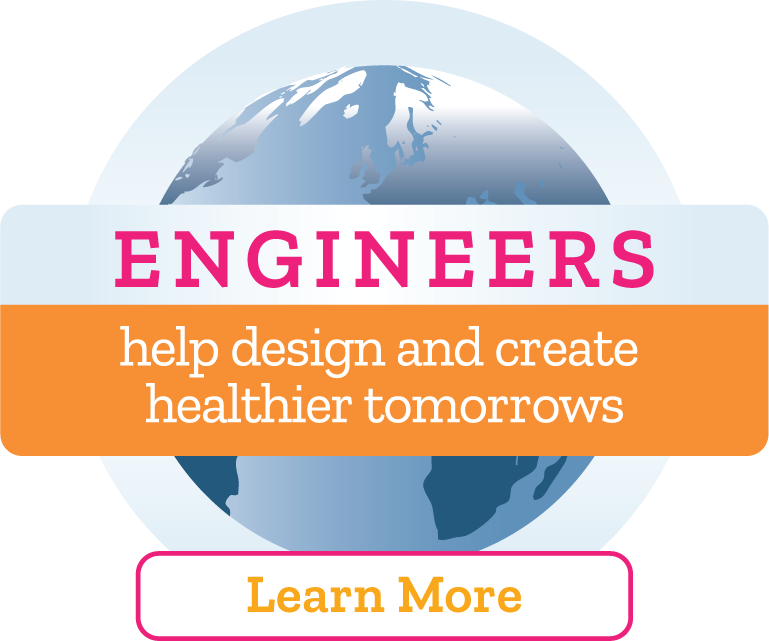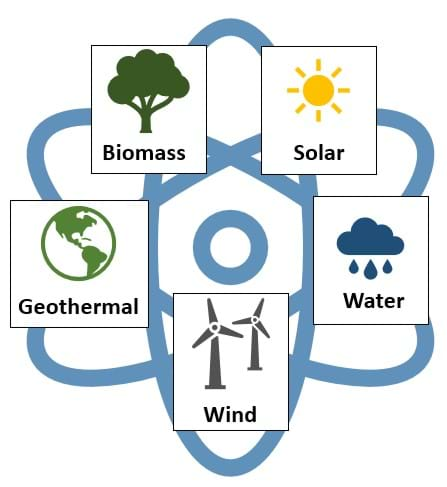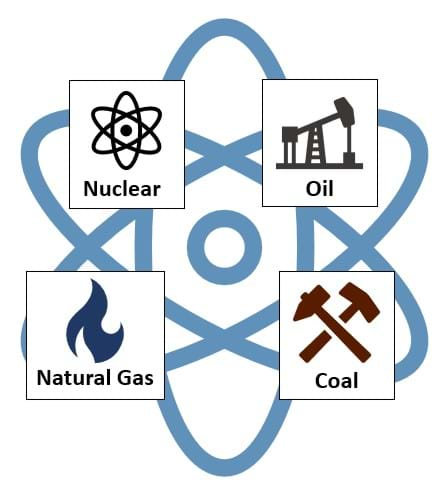

Units serve as guides to a particular content or subject area. Nested under units are lessons (in purple) and hands-on activities (in blue).
Note that not all lessons and activities will exist under a unit, and instead may exist as "standalone" curriculum.
| Unit | Lesson | Activity |

In this lesson, students are introduced to the five types of renewable energy resources by engaging in various activities to help them understand the transformation of energy (solar, water and wind) into electricity. Students explore the different roles engineers who work in renewable energy fields have in creating a sustainable environment – an environment that contributes to greater health, happiness and safety. This engineering curriculum aligns to Next Generation Science Standards (NGSS).

Engineers have a good understanding about energy, so they can harness renewable resources to create electricity for use in our everyday lives. Mechanical, electrical and civil engineers collaborate to develop new and more efficient ways to generate electricity from renewable resources. They design cleaner-burning engines and new car designs (such as hybrid cars) that require less fuel and result in improved gas mileage which in turns improves our planet.
Each TeachEngineering lesson or activity is correlated to one or more K-12 science, technology, engineering or math (STEM) educational standards.
All 100,000+ K-12 STEM standards covered in TeachEngineering are collected, maintained and packaged by the Achievement Standards Network (ASN), a project of D2L (www.achievementstandards.org).
In the ASN, standards are hierarchically structured: first by source; e.g., by state; within source by type; e.g., science or mathematics; within type by subtype, then by grade, etc.
4-ESS3-1. Obtain and combine information to describe that energy and fuels are derived from natural resources and their uses affect the environment. (Grade 4)
Do you agree with this alignment? Thanks for your feedback!
Alignment agreement: Thanks for your feedback!
Alignment agreement: Thanks for your feedback!
Alignment agreement: Thanks for your feedback!
Knowledge of relevant scientific concepts and research findings is important in engineering.
Alignment agreement: Thanks for your feedback!
Over time, people's needs and wants change, as do their demands for new and improved technologies.
Alignment agreement: Thanks for your feedback!
4-PS3-2. Make observations to provide evidence that energy can be transferred from place to place by sound, light, heat, and electric currents. (Grade 4)
Do you agree with this alignment? Thanks for your feedback!
Alignment agreement: Thanks for your feedback!
Alignment agreement: Thanks for your feedback!
Energy is present whenever there are moving objects, sound, light, or heat. When objects collide, energy can be transferred from one object to another, thereby changing their motion. In such collisions, some energy is typically also transferred to the surrounding air; as a result, the air gets heated and sound is produced.
Alignment agreement: Thanks for your feedback!
Light also transfers energy from place to place.
Alignment agreement: Thanks for your feedback!
Energy can also be transferred from place to place by electric currents, which can then be used locally to produce motion, sound, heat, or light. The currents may have been produced to begin with by transforming the energy of motion into electrical energy.
Alignment agreement: Thanks for your feedback!
Alignment agreement: Thanks for your feedback!
5-ESS3-1. Obtain and combine information about ways individual communities use science ideas to protect the Earth's resources and environment. (Grade 5)
Do you agree with this alignment? Thanks for your feedback!
Alignment agreement: Thanks for your feedback!
Alignment agreement: Thanks for your feedback!
Alignment agreement: Thanks for your feedback!
Brainstorm a list of ideas about where and when we use energy. (Answer: We use energy all the time. Humans use energy to be active – to walk, talk, play basketball, etc. We use energy to power our appliances, vehicles, lights, etc. Cells use energy to perform the most basic life functions. Life as we know it would not be possible without energy production and consumption.)
Energy is everywhere! Although sometimes you can hear energy (sound), feel energy (wind), taste energy (food), and see energy (light), most often it is hard to figure out exactly where energy is.
Energy can move and change, but it cannot be destroyed. Almost every form of energy can be converted into other forms. It is similar to the heat you feel coming off a light bulb while it is on. The warmth is light energy changed to heat energy. Whatever form it is in, energy is essentially the ability for making something happen or, as scientists put it, "doing work."
Where do we get our energy? Well, a lot of energy originally comes from the sun. We get some energy directly from the sun when we use solar panels; however, most energy comes from fossil fuels (coal and oil), which got their energy from fossilized plants and other organisms that obtained their energy directly from the sun by a process called photosynthesis that occurred many years ago. There are many different types of energy, as we brainstormed earlier. Some of these types of energy are called renewable, or can be re-used, such as energy from the sun, wind or water. Other energy is called non-renewable because once it is used up, it is gone, like coal and oil.

Now, imagine yourself having surgery in a hospital and the power goes out. This scenario would be terrible. Fortunately, hospitals have backup generators (designed by engineers!) to prevent this from ever happening. Generators are like storage houses for energy and are usually powered by electricity from coal or fossil fuels. Generators are not normally attached to things like stoplights, railcars or computer networks, which is why we sometimes see stoplights that have gone out. Now, imagine that all of the above mentioned things are backed up with solar energy power or another type of stored renewable energy. This stored power, especially in the form of solar power, never becomes overloaded (which is what happens when the lights in your house or neighborhood go out). The renewable source is always supplying more energy; i.e., the sun is almost always shining on some part of the Earth, wind is always blowing, and rivers are always running. Storing renewable energy for power failures is a better idea because those energy supplies will never run out.
Engineers know all about energy and are currently designing new and more efficient ways to generate electricity using renewable resources. They are designing cleaner engines that use less fuel and new car designs that use electric motors. Today, we are going to look at how engineers can use sun, wind and water power to create electricity to run our homes, cars and everything else. Wow! What incredible engineering creativity!
Energy is the ability to do work (applying a force over a distance), to make things happen, to cause change, or to start motion (a change in position of an object with time). It is the capacity for vigorous activity.
Energy can move (be transferred) and change (be transformed), but it cannot be destroyed. Interactions produce changes in a system, although the total quantities of energy remain unchanged. For example, a power station produces electricity by changing the energy from fuel into electrical energy. A gas-fired power station burns gas, converting the gas' chemical energy into heat. Almost every form of energy can be converted into other forms. But whatever form it is in, energy is essentially the capacity for making something happen or, as scientists put it, "doing work."
Energy comes from many sources, directly or indirectly: power plants, people, food, light, windmills, turbines, fires, electrical circuits, the sun, machines, etc. All energy originally comes from natural resources, most of which originate from the sun.
We use energy to heat houses and buildings, provide light, heating water, break down food, play sports, do activities, operate vehicles, etc.
What are the Different Types of Energy?
Other energy sources, for example, include energy created from old car tires: this source fuels five power stations in the U.S. Also, engineers are trying to design new gas power stations (gas drives the electricity generators and then is reused to heat the plant). Lastly, methane that is produced in sanitary landfills may be used to make power.
How are Energy Sources Categorized?
| Non-Renewable Energy Sources | Renewable Energy Sources |
| Natural gas | Wind |
| Coal | Water |
| Oil | Solar |
| Other Fossil Fuels |
What are Engineers Doing to Improve Our Energy Sources?
Current uses of fossil fuels have catastrophic effects on our environment. Obtaining and using them destroys natural habitats and pollutes the air, water, and land. We can reduce this consumption of fossil fuels by finding alternative, renewable methods of energy production. Engineers are involved in many new technologies that will save our precious resources from devastating long-term effects.
And, engineers are improving the design of factories and products to make even more efficient use of our resources. They are designing cleaner engines that use less fuel and new car designs that run by electric motors. They are studying corals because they very efficiently use low levels of phosphate in the water for energy. Corals have fractal surfaces, and scientists believe that fractal surfaces could make many chemical reactions more efficient. They are working to make machines smaller and more efficient (industrial engineers/designers). For example, they developed fiber optics (thin glass cables to replace heavy metal ones for phones). These efforts contribute to a better, cleaner planet for all inhabitants. Wouldn't it be great to be an engineer making such an important difference in our lives?
Ask the students to describe some sources of renewable energy? (Answer: sun, wind, water) Can they list three specific ways that engineers are involved with renewable resources? (Possible answers: engineers study renewable resources to develop better ways to use these resources for energy generation; engineers design cars that run off renewable resources; engineers design generators that store the energy gathered from renewable resources; engineers develop wind farms to generate electricity for us to use; engineers develop hydropower plants to generate electricity for us to use; engineers are developing machines that are more efficient to reduce the amount of energy, renewable or non-renewable, that gets used; and engineers work to inform communities about what they can do to help conserve energy and use renewable resources.) Engineers work at developing new technologies that use renewable sources to contribute to greater health, happiness and safety of our Earth's inhabitants.
absorb: To be taken into a material without transmission or reflection.
active solar system: Solar power systems that use electrical or mechanical components, such as fans, pumps, and electrical controls in circulating fluids. These systems can be used for heating water or heating/cooling buildings.
anemometer: An instrument for measuring the velocity of wind.
convection: The transfer of thermal energy in a fluid (gas or liquid) by the circulation of currents in the heated fluid causing warmer packets to rise while cooler packets sink.
electromagnetic radiation: Electromagnetic energy transmitted in the form of waves or particles (photons); the electromagnetic spectrum, in order of increasing energy: radio waves, microwaves, infrared radiation, visible light, ultraviolet radiation, x-rays, gamma rays, cosmic-ray photons.
generator: A device that transforms mechanical energy into electrical energy.
heat exchanger: A device, such as an automobile radiator, that transfers heat from one liquid to another without allowing them to mix.
heat-transfer fluid: A fluid circulated in a heat exchanger; this fluid gains energy from one region and transfers it to another region.
hydraulic head: The difference in depth of a liquid at two given points; the pressure of the liquid at the lower point expressed in terms of this difference.
insulation: A material used to prevent the passage of heat, electricity, or sound (i.e., a non-conducting material).
passive solar system: Solar power systems that do not require electrical or mechanical components; these systems can be used for heating water or heating/cooling buildings.
penstock: A pipe or conduit used to carry water to a water wheel or turbine.
photovoltaic system: This is a system which converts solar energy into electricity.
reflect: This is when something such as sound waves or light waves bend back or return upon striking a surface.
regenerate: To re-grow or replace.
renewable energy: Energy that is made from sources that can be regenerated or reused is renewable.
rotor: The rotating part of an electrical or mechanical device is the rotor.
thermal mass: Materials that store thermal energy, such as water, concrete, brick, stone, adobe, tile, etc.
transmit: To allow the passage through a material.
turbine: A machine in which the kinetic energy of a moving fluid is converted into mechanical energy by causing a series of buckets, paddles, or blades on a rotor to rotate.
Brainstorming: Ask students to brainstorm ideas about where and when we use energy. (Possible answers: We use energy all the time. Humans use energy to be active – to walk, talk, play basketball, etc. We use energy to power our appliances, vehicles, lights, etc. Cells use energy to perform the most basic life functions. Life as we know it would not be possible without energy production and consumption.)
Guess the Amount!: Ask students the following questions and ask them to guess at the different percentages of energy use. Discuss and explain the answers.
Discussion: Ask students the following questions. Discuss the answers.
Lesson summary assessment
Future Timeline: Ask students to work in a group to imagine what today would be like if there were no electricity (permanently, not just a blackout situation). Ask them to develop a timeline describing what this typical day might be like. Ask them to really consider how they would feel and what they would do. Ask each group to present their timeline to the class.
Venn Diagram: Ask students to create a Venn Diagram to compare/contrast a form of renewable energy and a form of non-renewable energy. They should provide as many facts and details as they can.
Save a Watt: Ask students to engage in two energy saving activities before the next class period. Ask them to describe in detail the impact these actions had during the next class. You can have the students list the activities or write a paragraph and turn the assignment in.
Get the inside scoop on all things TeachEngineering such as new site features, curriculum updates, video releases, and more by signing up for our newsletter!
PS: We do not share personal information or emails with anyone. Subscribe to TE Newsletter
Upper Elementary Lesson
The Outer PlanetsStudents explore the outermost planets of our solar system: Saturn, Uranus and Neptune. They also learn about characteristics of Pluto and its interactions with Neptune. Students learn a little about the history of space travel as well as the different technologies that engineers develop to make spa.


Upper Elementary Lesson
Our Big Blue MarbleStudents are introduced to the fabulous planet on which they live. They learn how engineers study human interactions with the Earth and design technologies and systems to monitor, use and care for our planet's resources wisely to preserve life on Earth.


Upper Elementary Lesson
Life in Space: The International Space StationStudents are introduced to the International Space Station (ISS) with information about its structure, operation and key experiments.


Upper Elementary Lesson
Measure Twice, Cut OnceStudents learn the metric units engineers use to measure mass, distance (or length) and volume. They make estimations using these units and compare their guesses with actual values. To introduce the concepts, the teacher needs access to a meter stick, a one-liter bottle, a glass container that measu.

American Wind Association, www.awea.org
Boulder Community Network, Environmental Center, bcn.boulder.co.us/environment/
California Energy Commission, www.energyquest.ca.gov/
Energy Information Administration, Energy Kid's Page, www.eia.gov/kids/
Hewitt, Paul G. Conceptual Physics, Boston, MA: Addison Wesley Publishing Company, 2004.
Goswami, D. Yogi, Kreith, Frank, and Kreider, Jan F. Principles of Solar Engineering, Taylor & Francis Group, 2nd edition, 2000.
Graham, Ian, Taylor, Barbara, Fardon, John, Oxlad, Chris and Parker, Steve. Science Encyclopedia, Miles Kelly, 2000.
Milton Hydro, https://www.miltonhydro.com/Residential/Community/Power-Kids
National Renewable Energy Laboratory, www.nrel.gov
Snow, Theodore. The Dynamic Universe: An Introduction to Astronomy, Minnesota: West Publishing Company, 1988.
Steen, Anthena S., Steen, Bill, Bainbridge, David and Eisenberg. The Straw Bale House, Vermont: Chelsea Green Publishing Company, 1994.
Texas State Energy Conservation Office, www.infinitepower.org/lessonplans.htm
U.S. Department of Energy, energy.gov
U.S. Department of Energy, Energy Efficiency and Renewable Energy, www.eere.energy.gov
The contents of this digital library curriculum were developed under a grant from the Fund for the Improvement of Postsecondary Education (FIPSE), U.S. Department of Education and National Science Foundation GK-12 grant no. 0338326. However, these contents do not necessarily represent the policies of the Department of Education or National Science Foundation, and you should not assume endorsement by the federal government.
Last modified: January 19, 2024
Free K-12 standards-aligned STEM curriculum for educators everywhere.
Find more at TeachEngineering.org






Use of the TeachEngineering digital library and this website constitutes acceptance of our Terms of Use and Privacy Policy.
*The NGSS logo is a registered trademark of WestEd.
Neither WestEd nor the lead states and partners that developed the NGSS were
involved in the production of TE, and do not endorse it.






Use of the TeachEngineering digital library and this website constitutes acceptance of our Terms of Use and Privacy Policy.
*The NGSS logo is a registered trademark of WestEd.
Neither WestEd nor the lead states and partners that developed the NGSS were
involved in the production of TE, and do not endorse it.